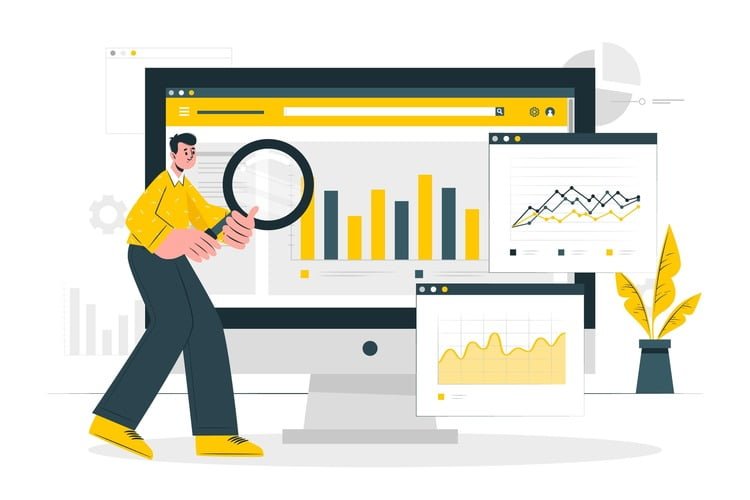Welcome to the fascinating world of website analytics! If you’ve ever wondered how people find your website, what they do once they’re there, and how effective your marketing efforts are, then Google Analytics (GA) is your key.

This free and powerful tool from Google unlocks a treasure trove of data, empowering you to understand your website visitors and optimize their experience. But where do you even begin? Don’t worry, this beginner’s guide will equip you with the essential knowledge to navigate Google Analytics and transform website insights into actionable strategies.
Demystifying the Basics: Key Metrics and Dimensions
Before diving into reports, let’s establish a foundation. Google Analytics operates on two core concepts: metrics and dimensions.
- Metrics: These are the quantitative aspects, the measurable data points. Examples include sessions (visits to your website), users (unique visitors), pageviews (individual page loads), and bounce rate (percentage of visitors leaving after one page).
- Dimensions: These provide context and categorize your website traffic. Examples include source (where visitors came from, e.g., search engine, social media), device (desktop, mobile, tablet), and location (visitor’s geographical area).
Imagine metrics as the “what” and dimensions as the “how” and “why.” By analyzing them together, you gain a deeper understanding of your website’s performance.
Setting Up Your Google Analytics Account
Now, let’s get your hands dirty! Here’s a quick guide to setting up your Google Analytics account:
- Head to Google Analytics: Create a free account if you haven’t already.
- Sign up for a Property: This represents your website. Provide your website URL and a descriptive name.
- Get Tracking Code: This magical code is the bridge between your website and Google Analytics. Install it on your website to collect data. Popular website building platforms often have built-in integrations to simplify this process.
Exploring the Google Analytics Interface

Once your tracking code is active, data will start flowing into Google Analytics. Let’s navigate the key sections of the interface:
- Home: This is your central dashboard, offering a quick overview of key metrics like sessions, users, and bounce rate. You can customize it with widgets displaying specific data points relevant to your goals.
- Reporting: This is where the real exploration begins! Dive into pre-built reports categorized by Acquisition (traffic sources), Behavior (user actions on your website), Conversion (goal completion), and User (demographic information).
- Customization: Don’t be afraid to personalize your experience! Create custom reports and segments to analyze specific aspects of your website traffic.
- Admin: Here, you can manage user access, data filters, and other settings for your Google Analytics account.
Understanding Key Reports for Beginners

Google Analytics offers a vast array of reports, but these three are crucial for beginners:
- Acquisition Reports: Uncover where your website traffic originates from. Sources like organic search (free traffic from search engines), paid search (traffic from ads), social media, and referrals (links from other websites) are all revealed here. By understanding your traffic sources, you can optimize your marketing efforts for maximum reach.
- Behavior Reports: Here, you can see how visitors interact with your website. Analyze pageviews, time spent on each page, user flow (how visitors navigate your website), and site search queries. This data helps you identify popular content, areas for improvement, and potential user engagement issues.
- Conversion Reports: Set up goals in Google Analytics to track specific actions you want visitors to take, such as completing a purchase, signing up for a newsletter, or downloading a file. Conversion reports reveal how effectively your website drives these desired actions.
Optimizing Your Website with Actionable Insights

Now that you’re comfortable with basic reports, let’s translate data into action! Here are some ways to leverage Google Analytics insights to optimize your website:
- Improve Content Strategy: See which content performs well and which falls flat. Use this data to refine your content strategy, create more engaging content, and cater to your audience’s needs.
- Enhance User Experience: Identify pages with high bounce rates or low average time on page. Investigate and address usability issues to improve user flow and website satisfaction.
- Refine Marketing Efforts: Analyze traffic sources and see which channels bring the most valuable visitors. Optimize your marketing campaigns to target the right audience on the right platforms.
- Track Conversions: Set up goals and monitor conversion rates to understand how well your website drives desired actions. Optimize your call-to-actions (CTAs) and landing pages to boost conversions.
Beyond the Basics: Advanced Features for Aspiring Analysts
As you become more comfortable with Google Analytics, you can delve into its advanced features to gain even deeper insights:
- Custom Dimensions and Metrics: Go beyond pre-defined metrics by creating custom ones to track specific data points relevant to your business. Similarly, create custom dimensions to categorize website traffic in unique ways (e.g., product category, content type).
- Segments: Isolate specific website visitor segments for targeted analysis. For example, segment visitors by location, device type, or referral source to see how these groups behave differently.
- Event Tracking: Track specific user interactions beyond pageviews, such as button clicks, video plays, or form submissions. This granular data empowers you to understand user engagement and optimize your website for user actions that matter.
- Funnel Analysis: Visualize the conversion process for your website goals. Track how visitors move through each stage of the funnel (e.g., product page visit, adding to cart, checkout) and identify drop-off points where you can optimize for better conversions.
- Data Studio: Take your data visualization a step further! Integrate Google Analytics with Data Studio, a free tool from Google, to create beautiful and interactive dashboards that showcase key website insights for you and your team.
Pro Tips for Mastering Google Analytics
- Stay Organized: Create a Google Analytics account structure that reflects your website and marketing campaigns. Use clear naming conventions for properties, views, and segments for easy navigation.
- Data Filtering: Utilize data filters to exclude unwanted traffic (e.g., internal IP addresses). This ensures your reports accurately reflect actual website visitors.
- Stay Updated: Google Analytics is constantly evolving. Regularly check the Google Analytics Help Center for updates, new features, and best practices.
Conclusion: The Power of Data-Driven Decisions
By leveraging Google Analytics, you unlock a treasure trove of website insights. From understanding your audience to optimizing content and marketing strategies, data empowers you to make informed decisions. Remember, Google Analytics is a journey, not a destination. As you experiment with its features and delve deeper into data analysis, you’ll gain a powerful competitive edge and unlock the true potential of your website.
Bonus Tip: Consider exploring Google Analytics Academy for free online courses and tutorials to further enhance your Google Analytics expertise.
How Digital Sprig Can Help
At Digital Sprig, we understand the importance of harnessing the power of Google Analytics. We offer a range of services to help you implement and utilize Google Analytics effectively:
- Account Setup and Tracking Code Installation: We’ll ensure your Google Analytics account is set up correctly and your tracking code is seamlessly integrated into your website.
- Custom Report Creation: We’ll create custom reports tailored to your specific business goals, providing you with the data that matters most.
- Data Analysis and Insights: Our experienced analysts will delve into your website data, identify key trends and patterns, and provide actionable insights to optimize your website performance.
- Ongoing Support: We’ll be your partner in your Google Analytics journey, offering ongoing support and guidance to ensure you continue to leverage data effectively.
By partnering with Digital Sprig, you can gain a comprehensive understanding of your website traffic, optimize your online presence, and achieve your digital marketing goals.





